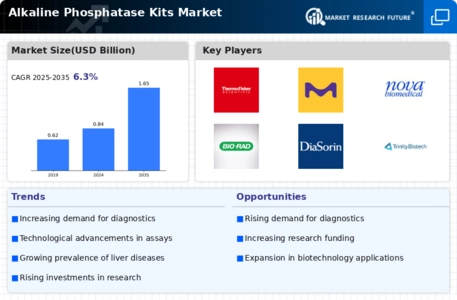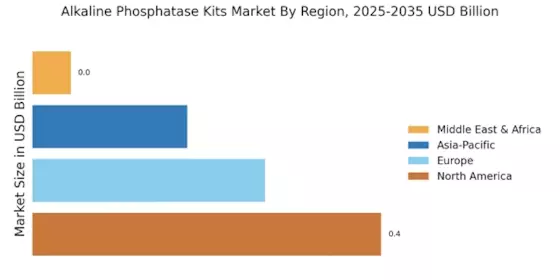Rising Prevalence of Chronic Diseases
The Alkaline Phosphatase Kits Market is significantly influenced by the rising prevalence of chronic diseases, including liver disease and osteoporosis. As populations age and lifestyle-related health issues become more common, the need for effective diagnostic tools is paramount. Alkaline phosphatase is a key enzyme involved in various metabolic processes, and its measurement is crucial for diagnosing and monitoring these conditions. Recent statistics indicate that the incidence of liver disease has increased by over 20% in the last decade, driving demand for alkaline phosphatase kits. This trend underscores the importance of these diagnostic tools in managing chronic health issues, thereby propelling the growth of the Alkaline Phosphatase Kits Market.
Growing Awareness of Personalized Medicine
The Alkaline Phosphatase Kits Market is increasingly shaped by the growing awareness of personalized medicine. As healthcare shifts towards tailored treatment approaches, the demand for diagnostic tools that can provide specific insights into individual patient profiles is rising. Alkaline phosphatase levels can vary significantly among individuals, making these kits valuable for personalized treatment plans. The integration of these diagnostic tools into clinical practice is likely to enhance patient outcomes by enabling more precise monitoring of treatment efficacy. Furthermore, the market for personalized medicine is projected to grow substantially, indicating a favorable environment for the Alkaline Phosphatase Kits Market as it aligns with the broader trends in healthcare.
Increasing Focus on Early Disease Detection
The Alkaline Phosphatase Kits Market is witnessing a growing emphasis on early disease detection, particularly in the context of liver and bone disorders. As healthcare providers prioritize preventive care, the demand for diagnostic tools that can identify conditions at an early stage is escalating. Alkaline phosphatase levels serve as critical biomarkers for various diseases, making these kits essential in clinical settings. According to recent data, the market for diagnostic kits is projected to expand at a compound annual growth rate of approximately 7% over the next five years. This trend suggests that the Alkaline Phosphatase Kits Market is poised for growth as healthcare systems increasingly adopt these kits for routine screening and monitoring.
Technological Advancements in Assay Development
The Alkaline Phosphatase Kits Market is experiencing a surge in technological advancements that enhance assay development. Innovations in enzyme labeling and detection methods are streamlining workflows and improving accuracy. For instance, the introduction of high-throughput screening technologies allows for the simultaneous analysis of multiple samples, significantly increasing efficiency. Furthermore, advancements in microfluidics and automation are likely to reduce human error and improve reproducibility in results. As laboratories seek to adopt these cutting-edge technologies, the demand for sophisticated alkaline phosphatase kits is expected to rise. This trend indicates a shift towards more precise and reliable diagnostic tools, which could potentially reshape the landscape of the Alkaline Phosphatase Kits Market.
Expansion of Research and Development Activities
The Alkaline Phosphatase Kits Market is benefiting from the expansion of research and development activities across various sectors, including pharmaceuticals and biotechnology. Increased funding for research initiatives is fostering innovation in enzyme-based assays, leading to the development of more advanced alkaline phosphatase kits. These kits are essential for drug discovery and development, as they facilitate the understanding of enzyme kinetics and metabolic pathways. Moreover, collaborations between academic institutions and industry players are likely to enhance the quality and variety of available kits. This collaborative environment suggests a promising future for the Alkaline Phosphatase Kits Market, as new products emerge to meet the evolving needs of researchers and clinicians.


















Leave a Comment